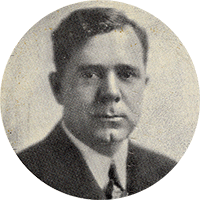In 1928, LSU was a small-time country school that generated little interest or attention in the state. Labeled a “third-rate” institution by the Association of State Universities, the school had only 1800 students, 168 faculty members, and an annual operating budget of $800,000.
In 1930, Huey Long initiated a massive building program on campus to expand the physical plant and add departments. By 1936, LSU had the finest facilities in the South, a top-notch faculty of 394 professors, a new medical school, more than 6,000 students, and a winning football team. In only eight years, it had risen in size from 88th in the nation to 20th, and it was the 11th largest state university in the nation.

Huey Long on the gridiron with referees before a Louisiana State University football game. ~ Courtesy of LSU Libraries Special Collections.
To generate excitement for LSU, Long’s first step was to quadruple the size of the marching band (from 28 to 125) and develop a first-rate football team. He became the state’s most prominent ‘Tiger fan’ – coaching plays, giving locker room pep talks and personally recruiting top talent for the team. LSU fever swept the state, as reduced tuition and need-based scholarships allowed students from all regions to flock to Baton Rouge to study.
Long financed these improvements by arranging for the state to purchase acreage from the LSU campus, which adjoined the grounds of the new State Capitol building. To the consternation of his critics, Long essentially diverted $9 million for LSU’s expansion and increased the annual operating budget to $2.8 million.




